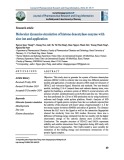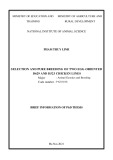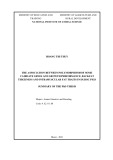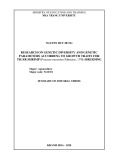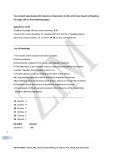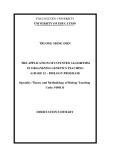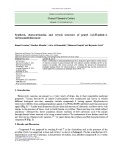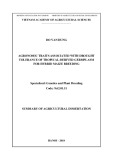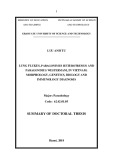Crystal structure of an ascomycete fungal laccase from Thielavia arenaria – common structural features of asco-laccases Juha P. Kallio1, Chiara Gasparetti2, Martina Andberg2, Harry Boer2, Anu Koivula2, Kristiina Kruus2, Juha Rouvinen1 and Nina Hakulinen1
1 Department of Chemistry, University of Eastern Finland, Joensuu, Finland 2 VTT Technical Research Centre of Finland, Espoo, Finland
Keywords ascomycete; C-terminal plug; laccase; proton transfer; redox potential
Correspondence N. Hakulinen, Department of Chemistry, University of Eastern Finland, Joensuu Campus, P.O. Box 111, FIN-80101 Joensuu, Finland Fax: +358 13 2513390 Tel: +358 13 2513359 E-mail: nina.hakulinen@uef.fi
(Received 8 March 2011, revised 20 April 2011, accepted 27 April 2011)
doi:10.1111/j.1742-4658.2011.08146.x
Laccases are copper-containing enzymes used in various applications, such as textile bleaching. Several crystal structures of laccases from fungi and bacteria are available, but ascomycete types of fungal laccases (asco-lac- cases) have been rather unexplored, and to date only the crystal structure of Melanocarpus albomyces laccase (MaL) has been published. We have now solved the crystal structure of another asco-laccase, from Thielavi- a arenaria (TaLcc1), at 2.5 A˚ resolution. The loops near the T1 copper, forming the substrate-binding pockets of the two asco-laccases, differ to some extent, and include the amino acid thought to be responsible for cata- lytic proton transfer, which is Asp in TaLcc1, and Glu in MaL. In addi- tion, the crystal structure of TaLcc1 does not have a chloride attached to the T2 copper, as observed in the crystal structure of MaL. The unique fea- ture of TaLcc1 and MaL as compared with other laccases structures is that, in both structures, the processed C-terminus blocks the T3 solvent leading towards the trinuclear centre, suggesting a common channel functional role for this conserved ‘C-terminal plug’. We propose that the asco-laccases utilize the C-terminal carboxylic group in proton transfer processes, as has been suggested for Glu498 in the CotA laccase from Bacillus subtilis. The crystal structure of TaLcc1 also shows the formation of a similar weak homodimer, as observed for MaL, that may determine the properties of these asco-laccases at high protein concentrations.
Database Structural data are available in the Protein Data Bank database under the accession numbers 3PPS and 2VDZ
Structured digital abstract l laccase binds to laccase by x-ray crystallography (View interaction)
Introduction
(benzenediol oxygen oxidoreductases) are Laccases enzymes belonging to the group of blue multicopper
oxidases, along with ascorbate oxidases [1], mamma- lian plasma ceruloplasmin [2], Escherichia coli copper
Abbreviations ABTS, 2,2¢-azinobis(3-ethylbenzo-6-thiazolinesulfonic acid); BsL, Bacillus subtilis laccase; 2,6-DMP, 2,6-dimethoxyphenol; MaL, Melanocarpus albomyces laccase; PDB, Protein Data Bank; RlL, Rigidoporus lignosus laccase; rMaL, recombinant Melanocarpus albomyces laccase; TaLcc1, Thielavia arenaria laccase; ThL, Trametes hirsuta laccase; TvL, Trametes versicolor laccase.
FEBS Journal 278 (2011) 2283–2295 ª 2011 The Authors Journal compilation ª 2011 FEBS
2283
J. P. Kallio et al.
Crystal structure of a Thielavia arenaria laccase
[15], Lentinus tigrinus
Laccases have recently been extensively studied by X-ray crystallography. The first complete laccase struc- tures were published in 2002, and crystal structures from at least 10 different organisms have now been reported. Most of the structures are from sporophoral basidiomy- cota fungi: Coprinus cinereus [10], Trametes versicolor [11,12], Rigidoporus lignosus [13], Cerrena maxima [14], Coriolus zonatus [16], Trame- [17], Trametes hirsuta [18], and Coriolopsis ter trogii gallica. Structures of bacterial laccases or multicopper oxidases are also available, including the spore coat pro- tein A from Bacillus subtilis [20], a copper efflux operob from E. coli [21], and the more recently published novel two-domain laccases [22–24]. The other phylum of the fungi, the Ascomycota or sac fungi, is much less studied, and only the crystal structure of Melanocarpus albomy- ces laccase (MaL) has been solved [25].
efflux operon, which is involved in copper homeostasis [3], a yeast plasma membrane-bound Fet3p that cataly- ses iron oxidation [4], and phenoxazinone synthase from Streptomyces antibioticus [5]. Laccases are com- mon in fungi, and are also found in some higher plants and bacteria. These enzymes are capable of oxidizing various organic and even inorganic substrates; how- ever, in general, their substrates are phenolic com- pounds (such as those presented in Table 1). Phenolics are oxidized near the T1 copper to phenoxy radicals, which can then form a large variety of oxidation prod- ucts by radical reactions. The substrate variety can be increased by the use of redox mediators, such as 2,2¢-azinobis(3-ethylbenzo-6-thiazolinesulfonic acid) (ABTS). In addition, direct electron exchange between laccase and, for example, graphite electrodes [6,7] has been reported. The broad substrate range, wide pH optimum and thermostability of some laccases, as well as their use of oxygen as the terminal electron accep- tor, mean that these enzymes have great potential for several applications, such as pulp bleaching, textile dye fuel decolorization, delignification, bioremediation, cells, and sensors [8,9].
The fold of the three-domain laccases is composed of three b-barrel domains that are assembled around two catalytic copper-binding sites (Fig. 1). The active sites are formed by four copper cations, which are divided into three different types – type 1 (T1), type 2 (T2), and type 3 (T3) – by their characteristic spectro-
Table 1. Kinetic parameters for rMaL, TaLcc1, and ThL, measured with 2,6-DMP, syringic acid and methyl syringate in 25 mM succinate buf- fer at pH 4.5 and in 40 mM Mes buffer at pH 6.0 (25 (cid:2)C). Structural formulas of the substrates are presented. Redox potentials (E(cid:2)) of T1 coppers of the laccases and redox potentials of the substrates at pH 4.5 and pH 6.0 are provided, together with the redox potential differ- ences (DE(cid:2)) between the T1 coppers of the laccases and the substrates. ND, not determined.
2,6-DMP
Syringic acid
Methyl syringate
pH 4.5 E(cid:2) = 0.53 V
pH 6 E(cid:2) = 0.40 V
pH 4.5 E(cid:2) = 0.57 V
pH 6 E(cid:2) = 0.51 V
pH 4.5 E(cid:2) = 0.69 V
pH 6 E(cid:2) = 0.65 V
rMaL (E(cid:2) = 0.48 V)
) 0.05 18 ± 1 126 ± 2
0.08 9.5 ± 0.9 119 ± 1
) 0.09 122 ± 11 3.5 ± 0.1
) 0.03 132 ± 22 12.1 ± 0.6
) 0.21 ND ND
) 0.17 ND ND
DE(cid:2) (V) Km (lM) Vmax (dA min)1Ænmol)1)
TaLcc1 (E(cid:2) = 0.51 V)
0
) 0.02 45 ± 4 99 ± 2
0.11 5.8 ± 0.6 87 ± 1
) 0.06 128 ± 4 3.5 ± 0.1
61 ± 4 2.7 ± 0.1
) 0.18 ND ND
) 0.14 ND ND
DE(cid:2) (V) Km (lM) Vmax (dA min)1Ænmol)1)
ThL (E(cid:2) = 0.78 V)
0.21
0.27
0.25 18 ± 1 193 ± 3
0.38 6.3 ± 1.3 91 ± 2
35 ± 6 8.3 ± 0.4
17 ± 4 2.0 ± 0.1
0.09 168 ± 19 21 ± 1
0.13 50 ± 16 2.6 ± 0.2
DE(cid:2) (V) Km (lM) Vmax (dA min)1Ænmol)1)
FEBS Journal 278 (2011) 2283–2295 ª 2011 The Authors Journal compilation ª 2011 FEBS
2284
J. P. Kallio et al.
Crystal structure of a Thielavia arenaria laccase
Fig. 1. (A) The crystal structure of TaLcc1 as a surface model. Domain A is presented in blue, domain B in green, and domain C in yellow. The N-glycans are shown as red sticks. Glycans are named as G1 on Asn89, G2 on Asn202, G3 on Asn217, G4 on Asn247 (on the other side of the molecule), G5 on Asn290, and G6 on Asn376. (B) Cartoon representation of TaLcc1. The catalytic coppers are shown in orange, and the C-terminal plug in purple.
Results and Discussion
Overall structure
The crystal structure of TaLcc1 was solved to 2.5-A˚ resolution from pseudomerohedrally twinned crystals by molecular replacement, using the recombinant MaL expressed in Trichoderma reesei [rMaL; Protein Data [33] as a model. The real Bank (PDB) code 2Q9O] space group was P21, and it was mimicking ortho- rhombic (b = 90.3(cid:2)). This led us to the solution with four molecules in an asymmetric unit, with a Matthews coefficient probability of 2.61 A3ÆDa)1 and a solvent content of 52.9%. Interestingly, molecules A and B (and C and D) formed a similar weak dimer as previ- ously reported for rMaL [33]. Thus, the asymmetric unit contained two weak TaLcc1 dimers (Fig. 1).
The crystal
scopic features. The T1 copper is responsible for the characteristic blue colour of these enzymes, and has strong absorption at 600 nm. The T1 and T2 coppers are paramagnetic, and can be detected by EPR spec- troscopy. The T3 coppers form an antiferromagneti- cally coupled dinuclear copper–copper pair, and are therefore EPR silent, although these coppers cause absorbance at 330 nm. The loops surrounding the T1 copper form the phenolic substrate-binding site of the enzyme, whereas the T2 and the T3-pair coppers form the trinuclear site that is responsible for binding and reduction of the molecular oxygen. The reduction of oxygen to two water molecules requires the transfer of four electrons [26,27]. The rate-limiting step for the catalysis is apparently the transfer of the first electron from the substrate to the T1 copper in laccase. The suitability of a chemical compound as a laccase sub- strate depends on two factors. First, the substrate must dock at the T1 copper site, which is mainly determined by the nature and position of substituents on the phe- nolic ring of the substrate. Second, the redox potential (E(cid:2)) of the substrate must be low enough, as the rate of the reaction has been shown to depend on the dif- ference between the redox potentials of the enzyme and the substrate (DE (cid:2)) [28–31].
domain A (Cys5–Cys13),
located
in
structure of TaLcc1 contained 564 amino acids. The overall structure was similar to that of other fungal laccases, especially the only known asco-laccase structure from M. albomyces [25]. Protein monomers of the two asco-laccases could be superim- posed with an rmsd of 0.65 A˚ for 558 Ca atoms. The fold is composed of three cupredoxin-like domains, called A (1–160), B (161–340), and C (340–564) (Fig. 1A,B), or sometimes referred to in the literature as domains I, II, and III. In TaLcc1, three disulfide bridges in domain B (Cys298–Cys332) and between domains A and C (Cys115–Cys545) stabilize the fold.
Most laccases are glycoproteins, with typically 3–10 glycosylation sites per monomer, although the func- tional role of the carbohydrates is not clear. Glycosyla- tion has been suggested to be involved, for example, in the stabilization of the catalytic centre, giving protection against hydrolysis, and improving the
This study presents the crystal structure of a novel laccase (TaLcc1) from the ascomycete fungus Thielavia arenaria [32]. The molecular mass of the enzyme is (cid:2) 80 kDa (based on SDS ⁄ PAGE), and it shows multi- ple bands in IEF. The pH optimum is 5.5, but the enzyme retains substantial activity at pH 7. The three- dimensional structure of TaLcc1 shows both similari- ties to and differences from the analogous structures of the ascomycete laccase (asco-laccase) MaL, thus giv- ing a comprehensive view of the structure and function of asco-laccases.
FEBS Journal 278 (2011) 2283–2295 ª 2011 The Authors Journal compilation ª 2011 FEBS
2285
J. P. Kallio et al.
Crystal structure of a Thielavia arenaria laccase
thermostability of the enzyme [34]. On the basis of the sequence of TaLcc1, there are eight putative N-glycosyl- ation sites (Asn89, Asn202, Asn217, Asn247, Asn290, Asn337, Asn376, and Asn396), and carbohydrate resi- dues were found on six of these sites (Asn89, Asn202, Asn217, Asn247, Asn290, and Asn376) in our crystal structure (Fig. 1A). The carbohydrate composition slightly varied between the molecules in the asymmetric unit; however, the glycans attached to Asn89 (G1 in Fig. 1A) and to Asn202 (G2 in Fig. 1A) were consistent in all four molecules. These two glycans seem to have a clear stabilizing effect on the multidomain protein struc- ture. The glycan on Asn89 was located alongside the C- terminal tail between all three domains (Fig. 2A), and had two hydrogen bonds with Ser180 and Asn555. The glycan on Asn202 was in the groove between the b-bar- rels of domains A and B (Fig. 2B), and had six hydro- gen bonds, three to the main chain carbonyls at Asn6, Leu168, and Val170, and three to the side chains of Arg11, Arg71, and Tyr216.
Fig. 2. Stabilizing carbohydrates of TaLcc1. Domain A is presented in blue, domain B in green, and domain C in yellow. (A) The glycan on Asp89 stabilizes the C-terminal tail (marked in purple). (B) The glycan on Asp202 is located on the groove between domain A and domain B. The 2Fo – Fc electron density for the carbohydrates is presented in cyan, contoured at 1r.
The catalytic centres were arranged in similar way as previously reported for MaL [25]. In the mononu- clear centre, the T1 copper was coordinated to two ND1 atoms of His residues. The residues in the axial positions of the mononuclear centre were Leu and Ile. The trinuclear centre had two type 3 coppers (T3 and T3¢), each being coordinated to three nitrogen atoms of His residues. The T2 copper was coordinated to two nitrogens of His residues. On the basis of the elec- tron density, we refined one oxygen atom (probably a hydroxide) between the type 3 coppers in molecules B, C and D in the asymmetric unit of the crystal struc- ture. However, the electron density among the coppers in molecule A was stronger than in the other mole- cules, and had a slightly elliptic shape towards the T2 copper. On the basis of these observations, we decided to refine a dioxygen molecule at this site. Another oxy- gen atom (most likely a hydroxide or a water mole- cule) was coordinated to the T2 copper on the opposite side (in the T2 solvent channel). No chloride was observed, even though the purified enzyme was in Tris ⁄ HCl buffer. In the crystal structure of MaL ⁄ rMaL, a chloride is bound to the T2 copper, whereas in other published laccase crystal structures, an oxygen atom, most likely in a hydroxide ion, is reported to be here.
T2 solvent channel
The water channel leading to the trinuclear centre from the side of the T2 copper, between domains A and C, can be found in all fungal laccases except in in rMaL, where His98 blocks the access. The T2 cavity is
surrounded by acidic Asp residues (Fig. 3), which have been suggested to provide the protons required for di- oxygen reduction in Fet3p multicopper oxidase [35]. In our TaLcc1 structure, His98 was replaced by Arg99, orientated such that it formed the surface of the sol- vent channel. Therefore, the access through the chan- nel was unhindered in TaLcc1 (Fig. 3A). It is possible that His98 in rMaL may also rotate to another confor- mation to open the T2 channel (Fig. 3B). On the basis of protein structure libraries, the ‘open conformation’ would be the second most favoured conformation. On the other hand, we did not observe any trace of the movements on the His98 residue in our MaL ⁄ rMaL
FEBS Journal 278 (2011) 2283–2295 ª 2011 The Authors Journal compilation ª 2011 FEBS
2286
J. P. Kallio et al.
Crystal structure of a Thielavia arenaria laccase
laccases. The T3 solvent channel gives the solvent access to the trinuclear centre. However, the channel is blocked by the C-terminal end of the amino acid chain in MaL ⁄ rMaL [25,33]. Similarly, in the structure of TaLcc1, the last four amino acids (DSGL) penetrate inside the channel. This is known as a C-terminal plug or a C-terminal tail. On the basis of the crystal struc- ture, the mature TaLcc1 enzyme lacks 40 residues at the N-terminus and 13 residues at the C-terminus as compared with the coded sequence. It has been previ- ously reported that the gene sequence of rMaL codes for 623 residues, but the secreted mature enzyme lacks 50 residues at the N-terminus and 14 residues at the C-terminus [36]. The C-terminal extension containing the last 14 (13 in TaLcc1) residues is post-translation- ally cleaved, and thus the active forms of both enzymes have DSGL as the last four amino acids penetrating into the channel.
site. Therefore,
The C-terminal processing has been reported for asco-laccases of different origins [37–39]; furthermore, the C-terminus of the mature asco-laccases is highly conserved, suggesting that the DSGL ⁄ V ⁄ I plug is most likely a characteristic feature of asco-laccases. Basidio- mycete laccases do not generally have this type of C-terminus. However, R. lignosus laccase (RlL) [13] has a C-terminal DSGLA sequence. Among the known basidiomycete laccases, RlL is phylogenetically the clos- est to asco-laccases. Although the last amino acids of RlL are not visible in the crystal structure, it is unlikely that the C-terminus of RlL would be long enough to form such a plug, as the last visible amino acid (Asn494) is located on the surface of the molecule and is rather far away from the trinuclear the C-terminal sequence of RlL might be more of an evolu- tionary relic than a functional feature of the enzyme.
Fig. 3. T2 solvent channels leading into the trinuclear centre of asco-laccases. (A) The open solvent channel in TaLcc1. The cavity is formed between domain A (blue) and domain C (yellow). (B) The in rMaL. His98 (corresponding to Arg99 in closed solvent channel TaLcc1) blocks the solvent channel in rMaL. The putative open con- formation of His98 is shown in purple. In the rMaL structure, the chloride is located in the upper cavity.
the phenolic
substrates was not
crystal structures. In our near-atomic crystal structure of rMaL, His98 exists in its oxidized form, possibly because of the oxidative stress [33]. The oxidation of the His residues probably affects its ability to change the side chain conformation, which may have implica- tions for the catalytic function of this laccase.
The actual role of the C-terminus in asco-laccases has been unclear. However, we have recently shown that a mutation in the C-terminus of rMaL affects both the activity and the stability of the enzyme [40]. The Leu559 fi Ala mutation greatly reduced the turn- over number for ABTS, whereas the turnover number for significantly altered. In addition, deletion of the four last amino acids (delDSGL) of rMaL resulted in a practically inactive form of the enzyme [40]. Therefore, it is obvi- ous that the C-terminal amino acids are critical for the function of asco-laccases. Furthermore, the C-terminal extension (the amino acids after the cleavage site) has been shown to affect the secretion process and folding of asco-laccases [41].
Role of the C-terminus
In addition to the T2 solvent channel, a so-called T3 solvent channel is generally reported in basidiomycete
Very recently, studies on a CotA laccase from B. subtilis (BsL) have provided evidence for Glu498 near the T3 coppers participating in the catalytic
FEBS Journal 278 (2011) 2283–2295 ª 2011 The Authors Journal compilation ª 2011 FEBS
2287
J. P. Kallio et al.
Crystal structure of a Thielavia arenaria laccase
Fig. 4. The trinuclear centres of (A) TaLcc1, (B) rMaL, (C) TvL, and (D) BsL. The distance of the putative catalytic carboxyl group from the oxygen species between the T3 coppers is shown.
B. subtilis CotA laccase. The SDS gate is formed by two Ser residues and one Asp residue, and it is thought to be involved in proton transfer from the T1 site to the trinuclear centre [33]. In TaLcc1, Ser143, Ser511 and Asp561 form the SDS gate, which possibly assists the proton flow. Laccases from different organ- isms might thus have adopted different strategies to facilitate proton transfer for the dioxygen reduction.
Oxidation of phenolic substrates
function of the enzyme, possibly by promoting proton transfer [42,43]. The fungal laccase structures have no Glu or Asp in this position, but basidiomycete fungal laccases have a conserved Asp in close proximity, i.e. Asp456 in T. versicolor laccase. In asco-laccases, the only acidic residue in the T3 solvent cavity that is close enough to assist in the proton transfer is the carboxyl- ate from the C-terminus. The C-terminal carboxylate group of asco-laccases and the conserved Asp of the basidiomycete laccases are both (cid:2) 7 A˚ from the oxy- gen species located between the T3 coppers. Glu498 of BsL is 4.7 A˚ from this oxygen (Fig. 4). It is plausible carboxylate the C-terminal that asco-laccases use group and basidiomycete laccases use the conserved Asp to assist proton transfer for reducing the molecu- lar oxygen. Nevertheless, the continuous flow of pro- tons from the phenolic substrate might come through the so-called SDS gate, which is conserved in asco-lac- cases but not detected in basidiomycete laccases or the
The substrate-binding pocket of TaLcc1 is similar to that in MaL, but there are clear differences in both the size and the shape of the pocket (Fig. 5A,B). Leu297 in TaLcc1 (Ala297 in MaL) narrows the cavity as compared with MaL, whereas Pro195 and Val428 (Phe194 and Phe427 in MaL) make the cavity in TaL- cc1 wider in the other direction. In addition, the loop with Val428 has an additional Ile427 in TaLcc1. This
FEBS Journal 278 (2011) 2283–2295 ª 2011 The Authors Journal compilation ª 2011 FEBS
2288
J. P. Kallio et al.
Crystal structure of a Thielavia arenaria laccase
Fig. 5. (A, B) The substrate-binding pockets of (A) TaLcc1 and (B) rMaL. (C) Superim- posed amino acids forming the substrate- binding pockets. TaLcc1 is shown in blue, rMaL in green, and 2,6-DMP from the com- plex structure (PDB code 3FU8) in yellow. The amino acids of TaLcc1 are labelled.
loop resembles ‘the extended jut’ reported in LacB of Trametes sp., which was also suggested to be involved in substrate recognition [44].
residues
In TaLcc1,
10 hydrophobic
ferent para-substituents and different redox potentials. On the basis of our crystal structure of rMaL with 2,6- DMP [46], and the T. versicolor laccase (TvL) complex structure with 2,5-xylidine [11], the para-substituents would point out from the binding pocket and therefore not affect the substrate binding. The rate of laccase-ca- talysed reactions is thought to increase as the redox potential difference (DE(cid:2)) between the T1 copper and the substrate increases. In TaLcc1, the redox potential of the T1 copper is slightly higher (0.51 V) than that in rMaL (0.48 V), but not as high as in ThL (0.78 V); thus, it would be expected that the kinetic data for TaLcc1 would fit in between the data of rMaL and ThL. However, our kinetic data clearly show that this is not the case, suggesting that the redox potential dif- ference is not the only factor contributing to the rate of substrate oxidation (Table 1).
(Ala193, Leu297, Leu363, Phe371, Trp373, Ile427, Val428, Leu430, Trp508, and His509) and one hydrophilic resi- due, Asp236, form the binding pocket. The most evi- dent difference between MaL and TaLcc1 is in this putative catalytic amino acid: TaLcc1 has an Asp236, instead of the Glu235 observed in MaL. Most basidio- mycete laccases, such as T. versicolor, L. tigrinus and C. cinereus laccases, have Asp residues here. In the crystal structure of the basiodiomycete T. hirsuta lac- case (PDB code 3FPX), the corresponding residue is an Asn, and it has been suggested that this contributes to the high catalytic constants of T. hirsuta [18]. How- ever, the purified laccase from T. hirsuta (ThL) (Uni- Prot Knowledgebase accession number Q02497) used in our experiments has an Asp here [45].
syringate] was
In order to understand the oxidation of phenolic compounds in the binding pockets of laccases, the kinetic behaviour of TaLcc1, rMaL and ThL on three phenolic compounds [2,6-dimethoxyphenol (2,6-DMP), syringic acid, and methyl studied (Table 1). The dimethoxy phenolic substrates have dif-
The kinetics of substrate oxidation by laccases has also been shown to be pH-dependent [47]. At higher pH values, phenolic substrates have lower E(cid:2) values, whereas E(cid:2) for the T1 copper of laccases seems to be unaffected by varying pH [28]. As consequence, when DE(cid:2) increases at the higher pH, the reaction rate is increased, but the inhibitory effect of hydroxide also increases. A typical feature of basidiomycete laccases is
FEBS Journal 278 (2011) 2283–2295 ª 2011 The Authors Journal compilation ª 2011 FEBS
2289
J. P. Kallio et al.
Crystal structure of a Thielavia arenaria laccase
the
catalytic
their acidic pH optima, whereas asco-laccases generally work in a more neutral range with phenolic com- pounds [48,49]. Therefore, kinetic studies were carried out at pH 4.5, which is more optimal for ThL, and at pH 6.0, which is, in general, more optimal for TaLcc1 and rMaL (Fig. S1). Because both the pH dependence and the difference in redox potential affect the kinetics of the laccases, we concluded that rMaL and TaLcc1 were able to oxidize syringic acid at pH 6.0, mainly owing to the favourable pH, whereas ThL could oxi- dize the same substrate, mainly because of the large difference in redox potential. However, the effect of the difference in redox potential outweighs the effect of pH for substrates with high E(cid:2), such as methyl sy- ringate. Oxidation of methyl syringate was only possi- ble with the high redox potential ThL, whereas the kinetic parameters for this substrate could not be determined with TaLcc1 or rMaL at either pH value (Table 1).
tion rate of rMaL with syringic acid at pH 6 as com- pared with pH 4.5. These differences in kinetic behaviour between TaLcc1 and rMaL must therefore be attributable to the variations in several residues likely Asp236, forming the binding pocket, most Ala193 and Val428 observed in TaLcc1 instead of Glu235, Pro192 and Phe427 observed in rMaL. Our mutagenesis studies with MaL have demonstrated that residue Glu235 fi Asp mutation of clearly increases the Km value for phenolic substrates while not affecting the kcat value. Furthermore, both the Km and kcat values were clearly affected by the Glu235 fi Thr mutation, suggesting the importance of the carboxylic group for the catalytic activity [46]. In addition, Phe427 in rMaL (Val428 in TaLcc1) might be involved in placing substrate molecules into the cor- rect orientation for oxidation. In T. hirsuta, the loops forming the substrate-binding pocket are completely different, possibly accounting for the clear differences in reaction kinetics between basidiomycete laccases and asco-laccases.
Dimerization
In the TaLcc1 crystal structure, molecules A and B (and C and D) of the asymmetric unit form a weak dimer (Fig. 6). On the basis of calculations performed
Interestingly, TaLcc1 showed a lower Km for 2,6- DMP at pH 6.0 than at pH 4.5 (Table 1). Despite the small difference in redox potentials of the two asco- laccases and their very similar pH optimum profiles, the affinity of TaLcc1 for 2,6-DMP was lower than the affinity of rMaL for the same substrate at pH 4.5. The similar pH profiles and DE(cid:2) values for the two asco- laccases do not explain the three-fold increase in reac-
Fig. 6. (A) Cartoon representation of dimers of TaLcc1 (blue) and rMaL (green). 2,6-DMP ligands (purple) are presented as they are in the rMaL complex structure (PDB code 3FU8). A surface representation of TaLcc1 (light blue) shows a small central channel that provides access for the substrates. (B, C) The contact amino acids at the dimeric interface in TaLcc1 (B) and rMaL (C). The residues from molecule A are shown in purple, and those from molecule B in yellow. The hydrogen bonding residues (according to Protein Interfaces, Surfaces and Assemblies) have been labelled, as have the hydrophobic residues with the closest contacts.
FEBS Journal 278 (2011) 2283–2295 ª 2011 The Authors Journal compilation ª 2011 FEBS
2290
J. P. Kallio et al.
Crystal structure of a Thielavia arenaria laccase
are
packed
pockets
fuel cells, dye bleaching, bioremediation, biological and sensors. The stability and activity over broad pH and temperature ranges are desired properties for industrial enzymes. With respect to industrial applica- tions, the ascomycete fungal laccase TaLcc1 is an effi- cient enzyme, particularly in denim bleaching, even at high temperatures and at neutral pH [32].
interacting
residues
Ile427
are
than that on MaL (796 A˚ 2
(667 A˚ 2)
with the Protein Interfaces, Surfaces and Assemblies service [50–52], the buried surface area for the weak is 3.2% (658 A˚ 2) and 3.3% dimers, AB and CD, (667 A˚ 2) of the total surface area, respectively. In this weak dimer, the loop areas surrounding the phenolic substrate-binding together (Fig. 6A). Similar dimerization has been reported in the crystal structure of MaL [33]. In MaL, one of the key residues for the dimeric interaction is Phe427, located at the edge of the substrate-binding pocket. This residue might be involved in the orientation or the docking of the substrate molecules. In MaL, the Phe residues from two molecules are packed face-to- face. In TaLcc1, the corresponding loop is longer, and the and Val428 (Fig. 6B). As a consequence, the T1–T1 copper dis- tance is slightly longer in TaLcc1 (28 A˚ ) than in MaL (27 A˚ ), and the surface contact area is also slightly for smaller 2Q9O).
is
In general, asco-laccases possess a wider optimal pH range than basidiomycete laccases; however, the cata- lytic ability of asco-laccases in less acidic conditions has not yet been fully clarified on the basis of the available laccase structures. It could be that the adap- tation of slightly different methods for proton transfer in asco-laccases and basidiomycete laccases (and in bacterial laccases) is responsible for the differences in the pH optimum range of laccases. In addition, the tri- nuclear site in asco-laccases is more protected, owing to the C-terminal plug; this might reduce the effect of hydroxide inhibition. Both TaLcc1 and MaL are also rather thermostable as compared with many other laccases. The stabilization of both the N-termini and C-termini of TaLcc1 and MaL might be a reason for the higher thermal stability. The extended C-terminus of asco-laccases is buried inside the solvent channel, and the extended N-terminus stabilized by an additional disulfide bridge. In addition, both termini interact with carbohydrates bound to the protein structure.
to the binding sites
Asco-laccases typically have middle redox potentials (TaLcc1, 0.51 V), whereas many basidiomycete lac- cases have very high redox potentials (ThL, 0.78 V), resulting in enhanced oxidation power. In the future, rational design methods could be used for tuning the redox potential of asco-laccases, or to increase the sta- bility and the optimal pH range of high redox poten- tial basidiomycete laccases. However, more studies are needed to understand how the enzyme structure con- tributes to the industrially desired properties.
Experimental procedures
Purification
It is possible that the weak dimers of MaL and TaLcc1 are the so-called ‘transient dimers’, which exist in solution as a mixture of monomers and dimers in a concentration-dependent manner [53]. It is noteworthy that the dimeric composition in MaL and TaLcc1 is very similar, suggesting that the ability to form dimers may have functional meaning. Interest- ingly, the two substrate-binding sites are packed against each other, and there is a shared cavity in the interface of the dimer. This cavity is enclosed in the MaL structure, whereas in the TaLcc1 structure there is a clear solvent channel in the interface between pro- tein molecules that provides free access of the sub- (Fig. 6A). strate molecules However, the cavity itself is more compact in TaLcc1 than in MaL, owing to the loop containing Ile427 and Val428. The other narrow solvent channel reported earlier for rMaL is also visible in TaLcc1 [46]. The observed dimer in the crystalline state favours smaller phenolic substrates without large sub- stituents in the para-position. The docking simulations based on the crystal structure for TaLcc1 reveal that substrates with large groups at the para-position clash with the loop containing Ile427 and Leu428. The cor- responding loop is shorter in MaL, and the cavity is also more spacious.
Industrial utilization
TaLcc1 was produced at Roal Oy (Rajama¨ ki, Finland), with Tr. reesei as host [32]. The culture supernatant was concentrated, buffer-exchanged, applied to a weak anion exchange column (DEAE Sepharose FF) in 5 mM Tris ⁄ HCl buffer (pH 8.5), and eluted with a linear 0–100 mM sodium sulfate gradient. Active fractions were pooled on the basis of ABTS activity, and were concentrated and desalted (Vivaspin, MWCO 10 000 Da). Typically, the laccase was further purified with a high-resolution anion exchange column (Resource Q) pre-equilibrated in 5 mM Tris ⁄ HCl
Laccases have wide reaction capabilities and possess great biotechnological potential, because of their broad substrate specificity. Laccases can be utilized in many textile industrial applications,
including biopulping,
FEBS Journal 278 (2011) 2283–2295 ª 2011 The Authors Journal compilation ª 2011 FEBS
2291
J. P. Kallio et al.
Crystal structure of a Thielavia arenaria laccase
highest-resolution
are P
for ÆIhæ. Rpim = P
h(1 ⁄ nh ) 1)1 ⁄ 2 P
h
h
l
Table 2. Summary of processing and refinement statistics. Values shells. Rmerge = in P l|Ihl ) ÆIhæ| ⁄ P
parentheses P P
l|Ihl ) ÆIhæ| ⁄ P l ÆIhæ.
h
Data collection
Wavelength (A˚ ) No. of images Crystal–detector distance (mm) Oscillation range ((cid:2)) Space group Unit cell
0.934 360 239.3 0.5 P21 a = 61.3, b = 178.9,
buffer (pH 8.5). The bound proteins were eluted with a lin- ear sodium sulfate gradient (0–100 mM). Active fractions were eluted at sodium sulfate concentrations between 5 and 40 mM, and concentrated. Subsequently, the buffer was changed to Tris ⁄ HCl (20 mM, pH 7.2). The protein yield from the purification was 6%, and the purification factor was 1.5.
MaL was overproduced in Tr. reesei, and purified basi- cally as described previously [54]. ThL, assigned with Uni- Prot Knowledgebase accession number Q02497 [45], was produced in its native host and purified in two chromato- graphic steps, as described previously [55].
Crystallization
118.1, b = 90.3 42.6–2.5 (2.6–2.5) 334 560 (49 270) 87 766 (12 787) 99.9 (99.9) 5.8 (2.9) 3.8 (3.9) 25.8 (44.1) 15.3 (26.0)
Resolution range (A˚ ) No. of reflections No. of unique reflections Completeness (%) I ⁄ r (I) Multiplicity Rmerge Rpim Analysis
Statistics independent of twin laws
Twin fraction estimated Twin law Refined twin fraction
1.99 0.83 0.67 0.38, 0.20 10.9 0.30 h, ) k, ) l 0.36
18.1 22.4 0.009 1.053
Refinement Rwork Rfree rmsd bond length from ideal (A˚ ) rmsd bond angles from ideal ((cid:2))
TaLcc1 was crystallized at room temperature with the hanging drop vapour diffusion method. Two microlitres of protein solution at a concentration of 9 mgÆmL)1 and 2 lL of crystallization solution were equilibrated against 500 lL of reservoir solution. Initial screens were made with Crystal Screen I by Hampton Research. Optimization of the molec- ular weight of poly(ethylene glycol) and its concentration, together with pH, led us to the final crystallization condi- tion of 7.5% poly(ethylene glycol) 3350, 0.2 M ammonium sulfate, and 0.1 M sodium acetate (pH 4.4). The streak seed- ing method with an equilibration time of (cid:2) 10 h was used to obtain better-quality crystals. The crystals grew as thin plates, which made them difficult to handle. The crystals were approximately 0.3–1 mm long and 0.15–0.5 mm wide, and the thickness of the crystals was always under 0.1 mm.
Data collection and structure refinement
Ramachandran plot Favoured (%) Allowed (%) Outlier (%)
92.9 7.0 0.1
also noticed a rather large off-origin peak, indicating some pseudotranslational symmetry that is most likely involved in the twinning with noncrystallographic symmetry.
Before data collection, TaLcc1 crystals were quickly soaked in a cryoprotectant solution containing the reservoir solu- tion with 25% glycerol. The crystal was then picked up with nylon loops and flash-frozen in liquid nitrogen. Data were collected at 100 K with synchrotron radiation at the European Synchrotron Radiation Facility (Grenoble) on beamline ID14-1, using an ADSC Q210 charge-coupled device detector. The data were indexed and integrated in MOSFLM [56], and scaled to 2.5-A˚ resolution in SCALA [57] from CCP4 [58]. The structure factors were created with TRUNCATE [59] from CCP4. A summary of the processing statistics is given in Table 2. The rather high Rmerge might be attributable to twinning or, additionally, to anisotropic diffraction patterns of the crystal.
FEBS Journal 278 (2011) 2283–2295 ª 2011 The Authors Journal compilation ª 2011 FEBS
2292
The structure was solved by molecular replacement with the rMaL structure (75% sequence identity) as a model. Molecular replacement was performed with PHASER [61] from the CCP4 package and the rMaL (PDB code 2Q9O) coordinates as a model. Only in space group P21 were rota- tion and translation solutions found that showed reason- able crystal packing. The R-values for the first round of refinement were R = 26.7% and Rfree = 34.9%. When a twin operator was included, R-value and Rfree-value were decreased to 19.2% and 25.2%, respectively. Refinement of the model and twin fraction were carried out with PHENIX, and model building in COOT [62]. The final R-values after the refinement were R = 18.1% and Rfree = 22.4%, and the twin fraction was refined to 0.36. Despite the twinning, The data were analysed with XTRIAGE from the PHENIX package [60]. The suggested lattice was monoclinic, but the highest possible lattice seemed to be orthorhombic. The multivariate L-tests strongly indicated that the data were twinned. The Z-score was 10.9, whereas the value should be under 3.5 for good-quality to reasonable-quality data. The twin operator for this case was (h, ) k, ) l), and the esti- mated twin fraction was about 0.3 (Table 2). In addition, we
J. P. Kallio et al.
Crystal structure of a Thielavia arenaria laccase
structural study of human ceruloplasmin in relation to ferroxidase activity. J Biol Inorg Chem 2, 454–463. 3 Roberts SA, Wildner GF, Grass G, Weichsel A,
Ambrus A, Rensing C & Montfort WR (2003) A labile regulatory copper ion lies near the T1 copper site in the multicopper oxidase CueO. J Biol Chem 278, 31958– 31963. 4 Taylor A, Stoj CS, Ziegler L, Kosman DJ & Hart J a surprisingly good-quality and continuous electron density map was symmetry observed. Noncrystallographic restraints were used during the refinement, and we also tried to release them, but this resulted in high B-factors for atoms in molecules C and D. Validation was performed with SFCHECK [63] from the CCP4 package, with 92.9% of all residues being in the most favourable region of the Ra- machandran plot (Table 2).
Kinetic data
(2005) The copper–iron connection in biology: structure of a metallo-oxidase Fet3p. Proc Natl Acad Sci USA 102, 15459–15464.
5 Smith AW, Camara-Artigas A, Wang M, Allen JP & Francisco WA (2006) Structure of phenoxazinone synthase from Streptomyces antibioticus reveals a new type 2 copper center. Biochemistry 45, 4378– 4387.
6 Thuesen MH, Farver O, Reinhammar B & Ulstrup J (1998) Cyclic voltammetry and electrocatalysis of the blue copper oxidase Polyporus versicolor laccase. Acta Chem Scand 52, 555–562. 7 Blanford CF, Heath RS & Armstrong FA (2007) A
stable electrode for high-potential, electrocatalytic O2 reduction based on rational attachment of a blue copper oxidase to a graphite surface. Chem Commun 17, 1710–1712. 8 Xu F (2005) Applications of oxidoreductases: recent progress. Ind Biotechnol 1, 38–50.
Kinetic constants (Km and Vmax) for rMaL, TaLcc1 and ThL were determined on 2,6-DMP, syringic acid, and methyl syringate, at both pH 4.5 and pH 6.0, in 25 mM suc- cinate buffer and 40 mM Mes buffer, respectively (Table 1). Kinetic measurements were performed in microtitre plates with a Varioskan kinetic plate reader (Thermo Electron Corporation, Waltham, MA, USA). The reactions were started by addition of substrate, and the rate of substrate oxidation was measured by monitoring the change in absor- bance over 5 min. All of the measurements were performed in duplicate, with eight substrate concentrations (0.008– 1.333 mM for 2,6-DMP and syringic acid; 0.008–2.800 mM for methyl syringate). The kinetic parameters were obtained by curve-fitting analysis with GRAPHPAD PRISM 4.01 (Graph- Pad Software). The pH optima of the three laccases were measured, with a substrate concentration of 1.7 mM, for 2,6-DMP, syringic acid and methyl syringate in McIlvaine’s buffer system at pH levels ranging from 2 to 8. 9 Rodrı´ guez Couto S & Toca Herrera JL (2006) Indus- trial and biotechnological applications of laccases: a review. Biotechnol Adv 24, 500–513. 10 Ducros V, Brzozowski AM, Wilson KS, Brown SH,
Acknowledgements
Ostergaard P, Schneider P, Yaver DS, Pedersen AH & Davies GJ (1998) Crystal structure of the type-2 Cu depleted laccase from Coprinus cinereus at 2.2 A resolu- tion. Nat Struct Biol 5, 310–316.
11 Bertrand T, Jolivalt C, Briozzo P, Caminade E, Joly N, Madzak C & Mougin C (2002) Crystal structure of a four-copper laccase complexed with an arylamine: insights into substrate recognition and correlation with kinetics. Biochemistry 41, 7325–7333.
12 Piontek K, Antorini M & Choinowski T (2002) Crystal structure of a laccase from the fungus Trameters versi- color at 1.90 A˚ resolution containing a full complement of coppers. J Biol Chem 277, 37663–37669. 13 Garavaglia S, Cambria MT, Miglio M, Ragusa S,
We are grateful to M. Paloheimo from Roal Oy for providing us with samples of TaLcc1. The ESRF is thanked for provision of synchrotron facilities. We also thank the staff members at beamline ID14-1 for their skilled assistance, and B. Hillebrant-Chellaoui at VTT for skilful help with the TaLcc1 purification. Roal Oy and the Academy of Finland (Project 115085) supported the work at Joensuu, and part of the VTT work was carried out with financial support from the Marie Curie EU-project ‘Enzymatic tailoring of pro- tein interactions and functionalities in food matrix’, PRO-ENZ (MEST-CT-2005-020924), and from the National Technology Agency of Finland, Tekes pro- ject 40522 ⁄ 02.
References
Iacobazzi V, Palmieri F, D’Ambrosio C, Scaloni A & Rizzi M (2004) The structure of Rigidoporus lignosus laccase containing a full complement of copper ions, reveals an asymmetrical arrangement for the T3 copper pair. J Mol Biol 342, 1519–1531. 1 Messerschmidt A, Ladenstein R & Huber R (1992)
FEBS Journal 278 (2011) 2283–2295 ª 2011 The Authors Journal compilation ª 2011 FEBS
2293
Refined crystal structure of ascorbate oxidase at 1.9 A˚ resolution. J Mol Biol 224, 179–205. 2 Lindley PF, Card G, Zaitseva I, Zaitsev V, Reinham- mar B, Selin-Lindgren B & Yoshida K (1997) An X-ray 14 Lyashenko AV, Bento I, Zaitsev VN, Zhukhlistova NE, Zhukova YN, Gabdoulkhakov AG, Morgunova EY, Voelter W, Kachalova GS, Stepanova EV et al. (2006) X-ray structural studies of the fungal laccase from Cerrena maxima. J Biol Inorg Chem 11, 963–973.
J. P. Kallio et al.
Crystal structure of a Thielavia arenaria laccase
15 Lyashenko AV, Zhukova Y, Zhukhlistova N, Zaitsev
28 Xu F (1996) Oxidation of phenols, anilines, and benzen- ethiols by fungal laccases: correlation between activity and redox potentials as well as halide inhibition. Biochemistry 35, 7608–7614. 29 Xu F, Shin W, Brown SH, Wahleithner JA, Sundaram V, Stepanova E, Kachalova G, Koroleva O, Voelter W, Betzel C, Tishkov V et al. (2006) Three-dimensional structure of laccase from Coriolus zonatus at 2.6 A˚ reso- lution. Crystallogr Rep 51, 817–823. 16 Ferraroni M, Myasoedova NM, Schmatchenko V,
UM & Solomon EI (1996) A study of a series of recombinant fungal laccases and bilirubin oxidase that exhibit significant differences in redox potential, substrate specificity, and stability. Biochim Biophys Acta Protein Struct Mol Enzymol 1292, 303–311. 30 Xu F, Kulys JJ, Cuke K, Li K, Kristopaitis K, Deussen Leontievsky AA, Golovleva LA, Scozzafava A & Briganti F (2007) Crystal structure of a blue laccase from Lentinus tigrinus: evidences for intermediates in the molecular oxygen reductive splitting by multicopper oxidases. BMC Struct Biol 7, 60, doi:10.1186/1472- 6807-7-6.
HW, Abbate E, Galinyte V & Schneider P (2000) Redox chemistry in laccase-catalyzed oxidation of N-hydroxy compounds. Appl Environ Microbiol 66, 2052–2056. 31 Xu F, Deussen HW, Lopez B, Lam L & Li K (2001) 17 Matera I, Gullotto A, Tilli S, Ferraroni M, Scozzafava A & Briganti F (2008) Crystal structure of the blue multicopper oxidase from the whiterot fungus Trametes trogii complexed with p-toluate. Inorg Chim Acta 361, 4129–4137.
18 Polyakov KM, Fedorova TV, Stepanova EV, Cherka- shin EA, Kurzeev SA, Strokopytov BV, Lamzin VS & Koroleva OV (2009) Structure of native laccase from Trametes hirsuta at 1.8 A resolution. Acta Crystallogr D65, 611–617. Enzymatic and electrochemical oxidation of N-hydroxy compounds: redox potential, electron transfer kinetics, and radical stability. Eur J Biochem 268, 4169–4176. 32 Paloheimo M, Valtakari L, Puranen T, Kruus K, Kallio J, Ma¨ ntyla¨ A, Fagerstro¨ m R, Ojapalo P & Vehmaan- pera¨ J (2006) Novel laccase enzyme and use thereof. European patent application WO ⁄ 2006 ⁄ 032723. 19 Reference withdrawn 20 Enguita FJ, Marc¸ al D, Martins LO, Grenha R, Henri-
33 Hakulinen N, Andberg M, Kallio J, Koivula A, Kruus K & Rouvinen J (2008) A near atomic resolution struc- ture of a Melanocarpus albomyces laccase. J Struct Biol 162, 29–39. ques AO, Lindley PF & Carrondo MA (2004) Substrate and dioxygen binding to the endospore coat laccase from Bacillus subtilis. J Biol Chem 279, 23472–23476.
34 Rodger CJ, Blanford CF, Giddens SR, Skamnioti P, Armstrong FA & Gurr SJ (2010) Designer laccases: a vogue for high-potential fungal enzymes? Trends Biotechnol 28, 63–72. 21 Li X, Wei Z, Zhang M, Peng X, Yu G, Teng M & Gong W (2007) Crystal structures of E. coli laccase CueO at different copper concentrations. Biochem Biophys Res Commun 354, 21–26. 35 Quintanar L, Stoj C, Wang T-P, Kosman DJ & Solo- 22 Komori H, Miyazaki K & Higuchi Y (2009) X-ray
mon EI (2005) Role of aspartate 94 in the decay of the peroxide intermediate in the multicopper oxidase Fet3p. Biochemistry 44, 6081–6091. structure of a two-domain type laccase: a missing link in the evolution of multi-copper proteins. FEBS Lett 583, 1189–1195. 36 Kiiskinen L-L & Saloheimo M (2004) Molecular clon-
ing and expression in Saccharomyces cerevisiae of a lac- case gene from the ascomycete Melanocarpus albomyces. Appl Environ Microbiol 70, 137–144. 37 Germann U, Muller G, Hunziker P & Lerch K (1988) 23 Lawton TJ, Sayavedra-Soto LA, Arp DJ & Rosenzweig AC (2009) Crystal structure of a two-domain multicop- per oxidase: implications for the evolution of multicop- per blue proteins. J Biol Chem 284, 10174–10180. 24 Ska´ lova´ T, Dohna´ lek J, Østergaard LH, Østergaard
Characterization of two allelic forms of Neuros- pora crassa laccase. Amino- and carboxyl-terminal pro- cessing of a precursor. J Biol Chem 263, 885–896. 38 Fernandez-Larrea J & Stahl U (1996) Isolation and PR, Kolenko P, Duskova´ J, Stepa´ nkova´ A & Hasek J (2009) The structure of the small laccase from Strepto- myces coelicolor reveals a link between laccases and nitrite reductases. J Mol Biol 385, 1165–1178.
characterization of a laccase gene from Podospora anse- rina. Mol Gen Genet 252, 539–551.
39 Bulter T, Alcalde M, Sieber V, Meinhold P, Schlacht- bauer C & Arnold FH (2003) Functional expression of a fungal laccase in Saccharomyces cerevisiae by directed evolution. Appl Environ Microbiol 69, 987–995. 25 Hakulinen N, Kiiskinen L-L, Kruus K, Saloheimo M, Paananen A, Koivula A & Rouvinen J (2002) Crystal structure of a laccase from Melanocarpus albomyces with an intact trinuclear site. Nat Struct Biol 9, 601–605. 26 Solomon EI, Sundaram UM & Machonkin TE (1996) Multicopper oxidases and oxygenases. Chem Rev 96, 2563–2606.
FEBS Journal 278 (2011) 2283–2295 ª 2011 The Authors Journal compilation ª 2011 FEBS
2294
27 Solomon EI, Chen P, Metz M, Lee S-K & Palmer AE (2001) Oxygen binding, activation, and reduction to water by copper enzymes. Angew Chem Int Ed 40, 4570–4590. 40 Andberg M, Hakulinen N, Auer S, Saloheimo M, Koiv- ula A, Rouvinen J & Kruus K (2009) Essential role of the C-terminus in Melanocarpus albomyces laccase for enzyme production, catalytic properties and structure. FEBS J 276, 6285–6300.
J. P. Kallio et al.
Crystal structure of a Thielavia arenaria laccase
41 Zuma´ rraga M, Camarero S, Shleev S, Martı´ nez-Arias
A, Ballesteros A, Plou FJ & Alcalde M (2008) Altering the laccase functionality by in vivo assembly of mutant libraries with different mutational spectra. Proteins 71, 250–260. 54 Kiiskinen L-L, Kruus K, Bailey M, Ylosmaki E, Siika- aho M & Saloheimo M (2004) Expression of Melano- carpus albomyces laccase in Trichoderma reesei and characterization of the purified enzyme. Microbiology 150, 3065–3074.
42 Chen Z, Dura˜ o P, Silva CS, Pereira MM, Todorovic S, Hildebrandt P, Bento I, Lindley PF & Martins LO (2010) The role of Glu498 in the dioxygen reactivity of CotA-laccase from Bacillus subtilis. Dalton Trans 39, 2875–2882. 55 Rittstieg K, Suurna¨ kki A, Suortti T, Kruus K, Guebitz G & Buchert J (2002) Investigations on the laccase-cata- lyzed polymerization of lignin model compounds using size-exclusion HPLC. Enzyme Microbial Technol 31, 403–410. 56 Leslie AGW (1992) Joint CCP4+ ESF-EAMCB. News- lett Protein Crystallogr 26, 27–33. 57 Weiss M (2001) Global indicators of X-ray data quality. J Appl Crystallogr 34, 130–135. 43 Bento I, Silva CS, Chen Z, Martins LO, Lindley PF & Soares CM (2010) Mechanisms underlying dioxygen reduction in laccases. Structural and modelling studies focusing on proton transfer. BMC Struct Biol 10, 28, doi:10.1186/1472-6807-10-28. 44 Ge H, Gao Y, Hong Y, Zhang M, Xiao Y, Teng M & 58 Collaborative Computational Project, Number 4 (1994) The CCP4 Suite: programs for protein crystallography. Acta Crystallogr D50, 760–763.
59 French GS & Wilson KS (1978) On the treatment of negative intensity observations. Acta Crystallogr A34, 517–525. 60 Adams PD, Grosse-Kunstleve RW, Hung L-W, Ioerger
Niu L (2010) Structure of native laccase B from Trametes sp. AH28-2. Acta Crystallogr F66, 254–258. 45 Frasconi M, Favero G, Boer H, Koivula A & Mazzei F (2010) Bio-electrochemical characterisation of high and low redox potential laccases from fungal and plant origin. Biochim Biophys Acta Proteins Proteom 1804, 899–908. TR, McCoy AJ & Moriarty NW (2002) PHENIX: build- ing new software for automated crystallographic struc- ture determination. Acta Crystallogr D58, 1948–1954.
46 Kallio JP, Auer S, Ja¨ nis J, Andberg M, Kruus K, Rouvinen J, Koivula A & Hakulinen N (2009) Structure–function studies of a Melanocarpus albomyces laccase suggest a pathway for oxidation of phenolic compounds. J Mol Biol 392, 895–909.
61 McCoy AJ, Grosse-Kunstleve RW, Adams PD, Winn MD, Storoni LC & Read RJ (2007) Phaser crystallo- graphic software. J Appl Crystallogr 40, 658–674. 62 Emsley P, Lohkamp B, Scott WG & Cowtan K (2010) Features and development of Coot. Acta Crystallogr D66, 486–501. 63 Vaguine AA, Richelle J & Wodak SJ (1999) 47 Xu F (1997) Effects of redox potential and hydroxide inhibition on the pH activity profile of fungal laccases. J Biol Chem 272, 924–928. 48 Kiiskinen L-L, Viikari L & Kruus K (2002) Purification
SFCHECK: a unified set of procedures for evaluating the quality of macromolecular structure-factor data and their agreement with the atomic model. Acta Crystallogr D55, 191–205. and characterization of a novel laccase from the ascomycete Melanocarpus albomyces. Appl Microbiol Biotechnol 59, 198–204.
Supporting information
49 Chakroun H, Mechichi T, Martinez MJ, Dhouib A & Sayadi S (2010) Purification and characterizaion of a novel laccase from the ascomycete Trichoderma atroviride: application on bioremediation of phenolic compounds. Process Biochem 45, 507–513. 50 Krissinel E & Henrick K (2005) Detection of protein
The following supplementary material is available: Fig. S1. The pH activity profiles of rMaL, TaL and ThL for 1.7 mM 2,6-DMP, syringic acid and methyl syringate.
This supplementary material can be found in the
assemblies in crystals. In Lecture Notes in Computer Sci- ence (Berthold MR ed), pp 163–174. Springer-Verlag, Berlin.
online version of this article.
51 Krissinel E & Henrick K (2007) Inference of macromo- lecular assemblies from crystalline state. J Mol Biol 372, 774–797. 52 Krissinel E (2009) Crystal contacts as nature’s docking solutions. J Comput Chem 31, 133–143. 53 Nooren MA & Thornton JM (2003) Structural
Please note: As a service to our authors and readers, this journal provides supporting information supplied by the authors. Such materials are peer-reviewed and may be re-organized for online delivery, but are not copy-edited or typeset. Technical support issues arising from supporting information (other than missing files) should be addressed to the authors.
FEBS Journal 278 (2011) 2283–2295 ª 2011 The Authors Journal compilation ª 2011 FEBS
2295
characterization and functional significance of transient protein–protein interactions. J Mol Biol 325, 991–1018.


